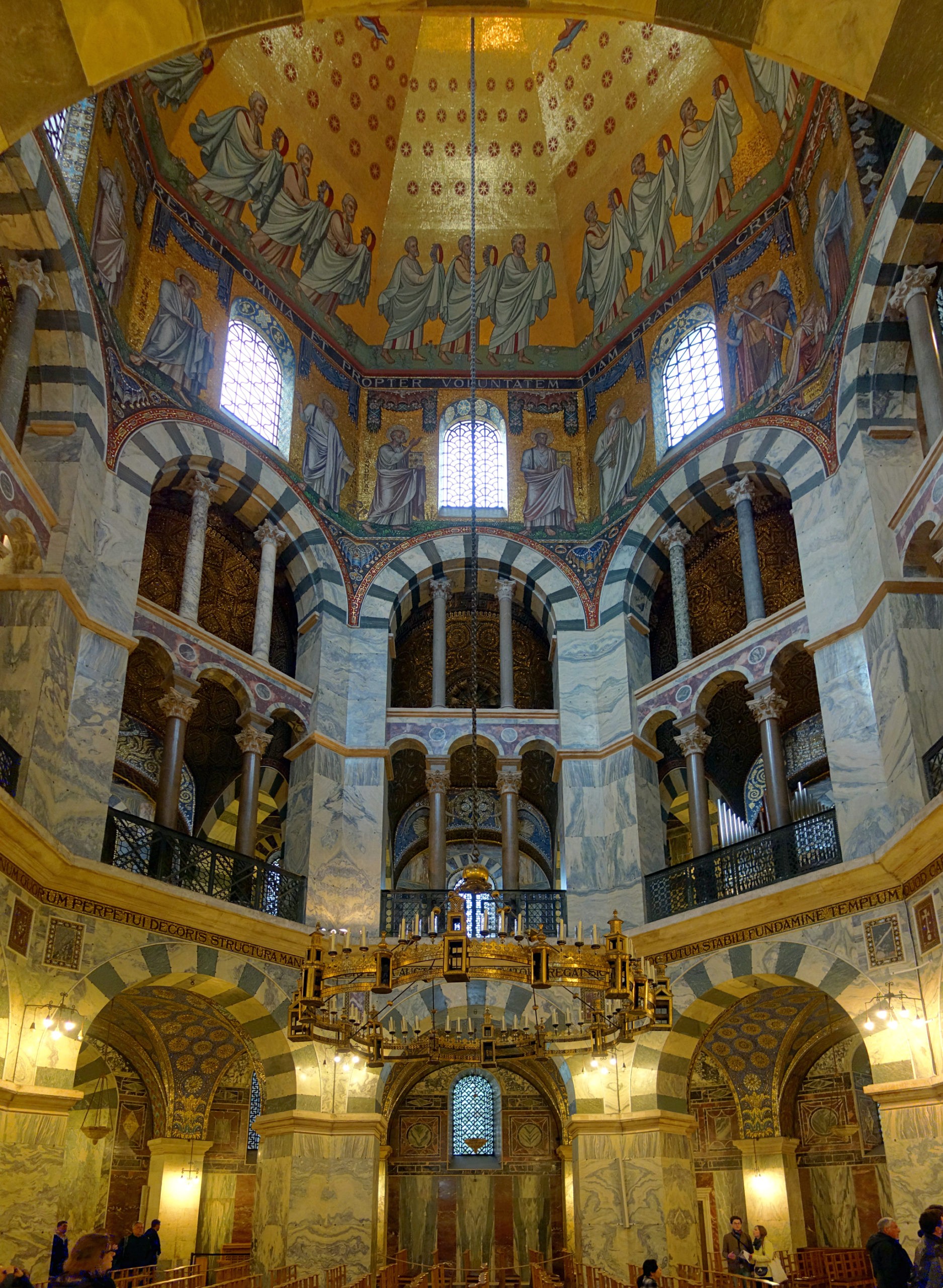Romanesque architecture, as the name suggests, draws heavily from the architectural vocabulary of ancient Rome. The defining characteristic of this style is the rounded Roman arch, which serves as the fundamental structural element.
The Legacy of Roman Arches
Throughout the former territories of the Roman Empire, remnants of Roman infrastructure, such as aqueducts and buildings, are visible. These structures prominently feature arches. The arch provided both structural support and a sense of visual harmony.
Alt text: Interior of Aachen Cathedral’s Palatine Chapel, highlighting the Romanesque arches and architectural style.
Charlemagne and the Revival of Roman Style
When Charlemagne was crowned Holy Roman Emperor in 800 C.E., the physical remnants and cultural memory of Roman civilization were widespread. To consolidate his empire and legitimize his rule, Charlemagne initiated the construction of churches inspired by Roman architecture, particularly the Christian Roman style prevalent during the reign of Constantine.
After a period of limited construction activity, Charlemagne’s architects looked to the arcaded system of Christian Roman buildings as a model. This system offered a logical approach to managing stresses and providing support, making it suitable for large-scale construction. Consequently, it was implemented in gatehouses, chapels, and churches across Europe.
Pre-Romanesque and the Rise of Romanesque Cathedrals
These early examples are often termed pre-Romanesque. Following a period of initial growth, architectural development experienced a lull. With the eventual re-development of architectural knowledge, buildings increased in size and grandeur. Romanesque cathedrals, built during the Early Middle Ages (roughly 1000–1200), are imposing structures that frequently remain the largest buildings in many towns. Their solid, massive construction reflects the architectural sensibilities of the time.
Alt text: The exterior of Gloucester Cathedral, featuring Norman Romanesque architecture from the 11th century.
Norman Architecture in Britain
In Britain, the Romanesque style is commonly referred to as “Norman” due to the extensive building program initiated by William the Conqueror following his invasion of Britain from Normandy in 1066. The Normans, descendants of Norse Vikings who had settled in northern France, brought their architectural expertise to England. Durham Cathedral, Gloucester Cathedral, and Southwell Minster are prime examples of churches built in the Norman, or Romanesque, style.
Alt text: The nave of Gloucester Cathedral, displaying the impressive Romanesque arches and geometric design.
Key Features of Romanesque Churches
The arches that define the naves of these churches are carefully proportioned and geometrically consistent. The repeating shapes and proportions provide a sense of visual order and structural stability for these immense structures. A large arcade at ground level consists of substantial piers or columns, often filled with rubble rather than solid carved stone. Above this arcade, a second level features smaller arches, frequently arranged in pairs with a column between them. The next level is proportionately smaller, creating a rational diminution of structural elements as the building’s mass decreases.
Alt text: Close-up of decorative carvings on the nave arcade and triforium in Gloucester Cathedral, showing geometric patterns characteristic of Romanesque design.
Decoration and Vaulting
Decoration in Romanesque architecture is often simple, featuring geometric shapes instead of floral or curvilinear patterns. Common motifs include diapers (squares or lozenges) and chevrons (zigzag patterns). Plain circles, echoing the semicircular shape of the ubiquitous arches, are also frequently used.
Early Romanesque ceilings and roofs were often constructed from wood, suggesting that architects had not yet fully mastered the techniques for spanning the building with stone, which created outward thrust and stresses on the side walls. However, the development of stone vaulting soon followed, progressing from barrel vaulting (simple, semicircular roof vaults) to cross vaulting, which became increasingly elaborate and ornate in the subsequent Gothic period.
In summary, Romanesque architecture, characterized by its use of rounded arches, massive structures, and geometric decoration, represents a significant chapter in the history of Western architecture, bridging the gap between the Roman era and the Gothic period.

